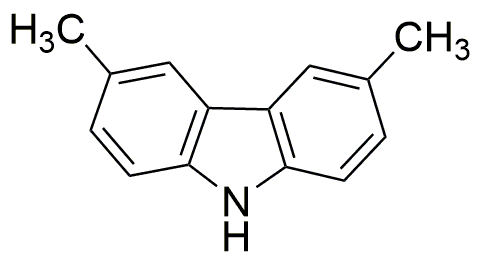3,6-Dimethylcarbazole is widely utilized in research focused on:
- Organic Electronics: This compound is used in the development of organic light-emitting diodes (OLEDs) and organic solar cells, enhancing their efficiency and stability.
- Pharmaceuticals: It serves as a precursor in the synthesis of various pharmaceutical compounds, particularly those targeting neurological disorders.
- Polymer Chemistry: 3,6-Dimethylcarbazole is employed in creating specialized polymers that exhibit unique electrical and optical properties, beneficial for advanced materials.
- Research in Photochemistry: This chemical is used in studies related to light absorption and emission, helping researchers understand photophysical processes in organic compounds.
- Environmental Applications: It is explored for its potential in developing sensors for detecting environmental pollutants, contributing to monitoring and remediation efforts.
General Information
Properties
Safety and Regulations
Applications
3,6-Dimethylcarbazole is widely utilized in research focused on:
- Organic Electronics: This compound is used in the development of organic light-emitting diodes (OLEDs) and organic solar cells, enhancing their efficiency and stability.
- Pharmaceuticals: It serves as a precursor in the synthesis of various pharmaceutical compounds, particularly those targeting neurological disorders.
- Polymer Chemistry: 3,6-Dimethylcarbazole is employed in creating specialized polymers that exhibit unique electrical and optical properties, beneficial for advanced materials.
- Research in Photochemistry: This chemical is used in studies related to light absorption and emission, helping researchers understand photophysical processes in organic compounds.
- Environmental Applications: It is explored for its potential in developing sensors for detecting environmental pollutants, contributing to monitoring and remediation efforts.
Documents
Safety Data Sheets (SDS)
The SDS provides comprehensive safety information on handling, storage, and disposal of the product.
Product Specification (PS)
The PS provides a comprehensive breakdown of the product’s properties, including chemical composition, physical state, purity, and storage requirements. It also details acceptable quality ranges and the product's intended applications.
Certificates of Analysis (COA)
Search for Certificates of Analysis (COA) by entering the products Lot Number. Lot and Batch Numbers can be found on a product’s label following the words ‘Lot’ or ‘Batch’.
*Catalog Number
*Lot Number
Certificates Of Origin (COO)
This COO confirms the country where the product was manufactured, and also details the materials and components used in it and whether it is derived from natural, synthetic, or other specific sources. This certificate may be required for customs, trade, and regulatory compliance.
*Catalog Number
*Lot Number
Safety Data Sheets (SDS)
The SDS provides comprehensive safety information on handling, storage, and disposal of the product.
DownloadProduct Specification (PS)
The PS provides a comprehensive breakdown of the product’s properties, including chemical composition, physical state, purity, and storage requirements. It also details acceptable quality ranges and the product's intended applications.
DownloadCertificates of Analysis (COA)
Search for Certificates of Analysis (COA) by entering the products Lot Number. Lot and Batch Numbers can be found on a product’s label following the words ‘Lot’ or ‘Batch’.
*Catalog Number
*Lot Number
Certificates Of Origin (COO)
This COO confirms the country where the product was manufactured, and also details the materials and components used in it and whether it is derived from natural, synthetic, or other specific sources. This certificate may be required for customs, trade, and regulatory compliance.


